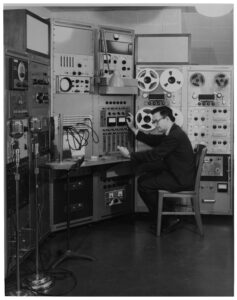When thinking about computer-generated art, it’s easy to immediately push your thoughts toward 21st century artificial intelligence software. It may be shocking, then, to hear that the first computer-composed piece of music, the Illiac Suite, debuted at the University of Illinois Urbana-Champaign campus over 40 years before the turn of the century. Lejaren Hiller with the assistance of Leonard Isaacson created it, through the limited computing power of the ILLIAC I, a massive machine that weighed five tons.

Despite his interest in music, Hiller was first and foremost a chemist. But, it was the similarity in methodologies between chemistry problems and music composition which led Hiller to experiment with the ILLIAC I. By feeding the computer a set of parameters, Hiller and Isaacson were able to complete a four-movement composition by the end of 1956, each movement corresponding with a program experiment.
The experiments increase in complexity over the course of the piece, beginning with relatively simple melodies in the first movement that are reminiscent of compositions written during the Renaissance. Although the melody was simple, there were many rules for the computer to follow in order to keep it simple.
The second movement consisted of four-voice segments and was only slightly more complex than the first. Hiller and Isacson changed the parameters slightly, especially focusing on changing from random white noise at the beginning of the movement to more organized music at the end.
In the third, the music became a lot more like modern, 20th century music, relying on the chromatic scale to form its basis, but ended up sounding too dissonant and had to be modified outside of the program.
The fourth and last movement was the most complex, utilizing non-musical techniques of probability (such as the Markov Chain Monte Carlo method) in order to showcase how a well-programmed computer could compose music even without help from historically accepted musical processes. All of the data that came from these experiments was then transcribed into sheet music for a string quartet.
On August 9, 1956, a Quartet of University of Illinois students performed the first three movements. Its debut took place in the Wedgewood Lounge within the Illini Union. This accomplishment was only the beginning of Hiller’s music career.
In 1958, Hiller founded the Experimental Music Studio (EMS) on campus, leading to his work on HPSCHD with John Cage, another composition based on the output of a computer program and electronic sounds that debuted in 1969. In that same year, another faculty member of the EMS, Salvatore Martirano, began to work on the Sal-Mar Contruction, an electronic device that allowed its users to compose in real-time. Also in 1969 was Martirano’s and David Rosenboom’s Moon Landing Concert, which took place in tandem with the Apollo 11 space flight and employed electronic musical pieces. Overall, Lejaren Hiller has left a long-lasting legacy on the Illinois campus and on computer music in general.
Charles Hamm, Lejaren Hiller, Salvatore Martirano, Herbert Brun, and Kenneth Gaburo standing in University of Illinois Computer Music Studio. (ca 1963 – 1968). Kenneth Gaburo Papers, Record Series 12/5/33 , Box 35, Folder 4. Sousa Archives and Center for American Music. University of Illinois. Chernysheva, A. (n.d.). Moon Landing Concert. Illinois Distributed Museum. Retrieved November 4, 2022, from https://distributedmuseum.illinois.edu/exhibit/moon-landing-concert/ Funk, T. (2018, September 1). A musical suite composed by an electronic brain reexamining the ILLIAC suite and the legacy of Lejaren A. Hiller Jr.. figshare. Retrieved November 4, 2022, from https://indigo.uic.edu/articles/journal_contribution/A_Musical_Suite_Composed_by_an_Electronic_Brain_Reexamining_the_Illiac_Suite_and_the_Legacy_of_Lejaren_A_Hiller_Jr_/10781933 Galbreath, M. (n.d.). HPSCHD. Illinois Distributed Museum. Retrieved November 4, 2022, from https://distributedmuseum.illinois.edu/exhibit/hpschd/ Herrerías, F., & Nunzio, A. D. (2011). Illiac Suite. Musica Informatica. Retrieved November 4, 2022, from http://www.musicainformatica.org/topics/illiac-suite.php Hiller, L., & Isaacson, L. M. (1959). Experimental music; composition with an electronic computer. Internet Archive. Retrieved November 4, 2022, from https://archive.org/details/experimentalmusi00hill/page/152/mode/2up Illiac and ordvac. Illinois Distributed Museum. (n.d.). Retrieved November 4, 2022, from https://distributedmuseum.illinois.edu/exhibit/illiac_and_ordvac/ Lejaren Hiller (3). (1960). Photographic Subject File, Record Series 39/2/20, Box FAC-4, Folder FAC-4 Hiller, Lejaren. University of Illinois Archives. Mills, T. (2019, February 21). Hear the first musical composition created by a computer: The ILLIAC suite (1956). Open Culture. Retrieved November 4, 2022, from https://www.openculture.com/2019/02/hear-the-first-composition-created-by-a-computer.html Sal-Mar construction. Illinois Distributed Museum. (n.d.). Retrieved November 4, 2022, from https://distributedmuseum.illinois.edu/exhibit/sal-mar_construction_/ Sen, A. (n.d.). Lejaren Hiller. Illinois Distributed Museum. Retrieved November 4, 2022, from https://distributedmuseum.illinois.edu/exhibit/lejaren-hiller/
